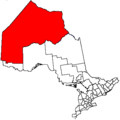m
Bot: Migrating 2 interwiki links, now provided by
Wikidata on
d:q3078079 |
No edit summary |
||
| Line 29: | Line 29: | ||
[[Category:Hudson's Bay Company forts]] |
[[Category:Hudson's Bay Company forts]] |
||
Robbie suckssjlko |
|||
{{NorthernOntario-geo-stub}} |
{{NorthernOntario-geo-stub}} |
||
Revision as of 16:50, 25 February 2014
55°59′25″N 87°37′59″W / 55.99028°N 87.63306°W

- For other uses of the names "Severn" and "Fort Severn", see Severn (disambiguation).
Fort Severn First Nation is located on Hudson Bay and is the most northern community in Ontario, Canada. As of 2001, the population was 401, consisting of 90 families in an area of 40 square kilometres. The legal name of the reserve is Fort Severn 89; most Indian reserves in Canada have a number after the name.
The town is linked by winter/ ice road called the Wapusk Trail in the winter to Peawanuck, Ontario in the east, and Shamattawa and Gillam, Manitoba to the west.
Fort Severn is policed by the Nishnawbe-Aski Police Service, an Aboriginal-based service.
History
This area was inhabited for thousands of years by varying cultures of indigenous peoples. At the time of European contact, the historic Ojibwa, an Anishinaabe-speaking people, lived in the area.
In 1689 the Hudson's Bay Company built Fort Severn at this site; it was one of the earliest English fur trading posts in the New World. After years of international competition between the English and French, with their wars playing out in North America, the French attacked the outpost and pillaged it in 1782 when they were allies of the Thirteen Colonies during the American Revolutionary War.
In the early 20th century, when the federal government negotiated a treaty with the First Nations, it set aside land for a native reserve in the Rocksand area at the confluence of the Severn and Sachigo Rivers, with the consent of the leaders at the time. In 1973, the reserve was relocated to the mouth of the Severn River on Hudson Bay, for more direct access to shipping. The reserve achieved full status on January 11, 1980.
External links
Robbie suckssjlko
m
Bot: Migrating 2 interwiki links, now provided by
Wikidata on
d:q3078079 |
No edit summary |
||
| Line 29: | Line 29: | ||
[[Category:Hudson's Bay Company forts]] |
[[Category:Hudson's Bay Company forts]] |
||
Robbie suckssjlko |
|||
{{NorthernOntario-geo-stub}} |
{{NorthernOntario-geo-stub}} |
||
Revision as of 16:50, 25 February 2014
55°59′25″N 87°37′59″W / 55.99028°N 87.63306°W

- For other uses of the names "Severn" and "Fort Severn", see Severn (disambiguation).
Fort Severn First Nation is located on Hudson Bay and is the most northern community in Ontario, Canada. As of 2001, the population was 401, consisting of 90 families in an area of 40 square kilometres. The legal name of the reserve is Fort Severn 89; most Indian reserves in Canada have a number after the name.
The town is linked by winter/ ice road called the Wapusk Trail in the winter to Peawanuck, Ontario in the east, and Shamattawa and Gillam, Manitoba to the west.
Fort Severn is policed by the Nishnawbe-Aski Police Service, an Aboriginal-based service.
History
This area was inhabited for thousands of years by varying cultures of indigenous peoples. At the time of European contact, the historic Ojibwa, an Anishinaabe-speaking people, lived in the area.
In 1689 the Hudson's Bay Company built Fort Severn at this site; it was one of the earliest English fur trading posts in the New World. After years of international competition between the English and French, with their wars playing out in North America, the French attacked the outpost and pillaged it in 1782 when they were allies of the Thirteen Colonies during the American Revolutionary War.
In the early 20th century, when the federal government negotiated a treaty with the First Nations, it set aside land for a native reserve in the Rocksand area at the confluence of the Severn and Sachigo Rivers, with the consent of the leaders at the time. In 1973, the reserve was relocated to the mouth of the Severn River on Hudson Bay, for more direct access to shipping. The reserve achieved full status on January 11, 1980.
External links
Robbie suckssjlko
